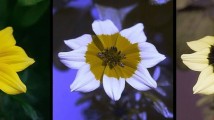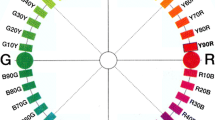Abstract
This paper explores the implications of some experimental data for views that identify colors with objective physical properties such as reflectance profiles. Those who reject objectivist views often argue from the existence of intersubjective differences in color categorization (application of color predicates); but objectivists have managed to stand their ground by (e.g.) identifying colors with sets or ranges of reflectances individuated by the ways in which they stimulate the visual system. In the interest of moving the debate forward, I provide a new kind of evidence against objectivism. Results of a psycholinguistic experiment (e.g., Raffman 2014) reveal hysteresis and enhanced contrast in ordinary speakers’ applications of vague terms. These dynamical patterns are purely psychological and give rise to intra-subjective variation in subjects’ applications of vague predicates; in particular, in the case of color predicates, nothing in the stimulus configuration or the illuminant undergoes any change, the only variable being the order in which stimuli are judged. I hypothesize that these order effects are necessary if vague words are to be applicable to values on dimensions, like color, that admit of continuous change. To the extent that this hypothesis is correct, it suggests that if (1) colors are the properties named by ordinary color predicates, and (2) ordinary color predicates are vague, and (3) the application of vague predicates exhibits the order effects found in the experiment, colours cannot be physical or otherwise objective in nature.
Access this chapter
Tax calculation will be finalised at checkout
Purchases are for personal use only
Similar content being viewed by others
Notes
- 1.
- 2.
This section and the next draw heavily on Raffman 2014, Chapter 5.
- 3.
- 4.
- 5.
In what follows I merely sketch the experiment; for a full account, see Raffman 2014, 146–156. I designed and ran the experiment with two colleagues in psychology of color vision at Ohio State University: Angela Brown (brown.112@osu.edu) and Del Lindsey (lindsey.43@osu.edu)
- 6.
See any psychophysics textbook.
- 7.
For the reason why, see Raffman, op.cit., 146–7.
- 8.
In fact the hysteresis is only part of the story, but sufficient for present purposes.
- 9.
Even the epistemicist about vagueness agrees that we are competent; see e.g. Williamson 1994.
- 10.
See Raffman 1994, 53.
- 11.
Of course one can infer, from the look of an object, that it will look blue to normal perceivers etc.,
- 12.
See Watkins 2002 for development of this idea.
- 13.
I am grateful to an anonymous referee for pointing out the need to address this issue.
- 14.
Similarly: do you know what a juniper tree looks like? Do you know what a zither sounds like? Do you know what poutine tastes like? (Perhaps it would be more idiomatic to say ‘Do you know how poutine tastes?’)
- 15.
In conversation.
- 16.
“The color signals spread by a process analogous to physical diffusion, until they encounter a strong contour such as a black line…. These effects seem to be consistent with what has been called isomorphic filling-in theory (see Von der Heydt et al. 2003), which relies on the idea that color spreads equally in all directions, except across contours)” (Vergeer et al. 2015, pp.1, 7).
- 17.
As I am using these terms, the surface of a blue object does, literally, have or instantiate blueness.
Bibliography
Ball, L. (2008). Hysteresis in unemployment. http://www.bos.frb.org/phillips2008/papers/Ball.pdf
Byrne, A., & Hilbert, D. (2003). Color realism and color science. Behavioral and Brain Sciences, 26, 1–44.
Dixit, A. (1992). Investment and hysteresis. Journal of Economic Perspectives, 6(1), 107–132.
Hilbert, D. R. (1987). Color and color perception. Stanford: CSLI Publications.
Horgan, T. (1994). Robust vagueness and the forced-march sorites paradox. Philosophical Perspectives, 8, 159–188.
Jackson, F. (1996). The primary quality view of color. Philosophical Perspectives, 10, 199–219.
Jackson, F. (2007). Color for representationalists. Erkenntinis, 66, 169–185.
Kamp, H. (1981). The paradox of the heap. In U. Mönnich (Ed.), Aspects of philosophical logic (pp. 225–277). Dordrecht: Reidel.
Matthen, M. (1988). Biological function and perceptual content. The Journal of Philosophy, 11, 5–27.
Nave, R. (2005). Hyperphysics. Department of Physics and Astronomy, Georgia State University. http://hyperphysics.phy-astr.gsu.edu/hbase/hph.htmlhph
Raffman, D. (1994). Vagueness without paradox. The Philosophical Review, 103(1), 41–74.
Raffman, D. (1996). Vagueness and context relativity. Philosophical Studies, 81, 175–192.
Raffman, D. (2014). Unruly words: A study of vague language. New York: Oxford University Press.
Shapiro, S. (2007). Vagueness in context. Oxford: Oxford University Press.
Soames, S. (1999). Understanding truth. New York: Oxford University Press.
Tesser, A., & Achee, J. (1994). Aggression, love, conformity, and other social psychological catastrophes. In R. Vallacher & A. Nowak (Eds.), Dynamical systems in social psychology (pp. 96–108). San Diego: Academic Press.
Tye, M. (2000). Consciousness, color, and content. Cambridge: MIT Press.
Vergeer, M., Anstis, S., & van Lier, R. (2015, May 18). Flexible color perception depending on the shape and positioning of achromatic contours. Frontiers in Psychology. https://doi. org/10.3389/fpsyg.2015.00620
Von der Heydt, R., Friedman, H. S., & Zhou, H. (2003). Searching for the neural mechanism for color filling-in. In L. Pessoa & P. de Weerd (Eds.), Filling-in: From perceptual completion to cortical reorganization (pp. 106–127). Oxford: Oxford University Press.
Watkins, G. M. (2002). Rediscovering colors: A study in Pollyanna realism. Dordrecht: Springer.
Williamson, T. (1994). Vagueness. London: Routledge.
Author information
Authors and Affiliations
Corresponding author
Editor information
Editors and Affiliations
Rights and permissions
Copyright information
© 2017 Springer International Publishing AG
About this chapter
Cite this chapter
Raffman, D. (2017). Vagueness, Hysteresis, and the Instability of Color. In: Silva, M. (eds) How Colours Matter to Philosophy. Synthese Library, vol 388. Springer, Cham. https://doi.org/10.1007/978-3-319-67398-1_14
Download citation
DOI: https://doi.org/10.1007/978-3-319-67398-1_14
Published:
Publisher Name: Springer, Cham
Print ISBN: 978-3-319-67397-4
Online ISBN: 978-3-319-67398-1
eBook Packages: Religion and PhilosophyPhilosophy and Religion (R0)




